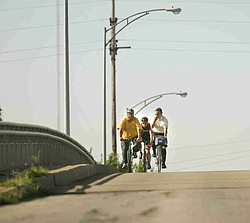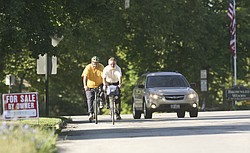The road less traveled
Cycle to Work

Frank Krygowski started riding his bicycle to work in 1977. When he moved to Youngstown to teach engineering at Youngstown State University in 1980, he didn’t stop bicycling to work. “It’s a beautiful way to see the world,” said Krygowski. “It’s environmentally beneficial, it keeps me in shape, and I think we relate to each other better as people if we’re out and engaged instead of sealed tightly in our cars.”
Cycling to Work

Frank Krygowski started riding his bicycle to work in 1977. When he moved to Youngstown to teach engineering at Youngstown State University in 1980, he didn’t stop bicycling to work. “It’s a beautiful way to see the world,” said Krygowski. “It’s environmentally beneficial, it keeps me in shape, and I think we relate to each other better as people if we’re out and engaged instead of sealed tightly in our cars.”
Frank Krygowski started riding his bicycle to work in 1977. When he moved to Youngstown to teach engineering at Youngstown State University in 1980, he didn’t stop bicycling to work.
“It’s a beautiful way to see the world,” said Krygowski. “It’s environmentally beneficial, it keeps me in shape, and I think we relate to each other better as people if we’re out and engaged instead of sealed tightly in our cars.”
His enthusiasm for cycling, and especially riding a bike to work, prompted he and others in the Out-Spokin’ Wheelmen bicycle club to create a map of greater Youngstown streets conducive to this idea.
The maps are available on their website, outspokinwheelmen.com, as well as at area bicycle shops. From all directions surrounding Youngstown — Austintown to Hubbard to Liberty to Canfield — the maps provide ideal roadways ranked from novice to advance.
On Thursday, I was on the route from Poland with Krygowski — going to work his way.
Some things to know about me and cycling:
I ride about five miles per year on a bike, and the miles are always downhill. The minivan carries me back up.
I plan to launch state legislation to put a weight limit on those tight cycling suits Frank’s friends wear. If your name is Lance Armstrong, it’s proper attire. If you are Lance Armenkovich, then no. (For the benefit of society, I did not wear one of those suits.)
We met in downtown Poland at 8 a.m. and were joined by Beaver Police Chief Carl Frost, an avid cyclist and member of Out-Spokin’.
The wise guy in me did wonder if, given that we’re cycling through Youngstown’s South and East sides, if a police escort came with the map. Um, no.
Krygowski said there was some conversation about the routes and city crime trends, but it was determined unnecessary. He said no club member has ever reported a crime against them while riding through the city (and they ride a lot).
Frost added that the map by no means suggests you ride home at 11 p.m. at night. The thought is that with logical thinking, along logical roads and at logical hours, you’re equally safe anywhere the map takes you.
In Poland, the map took us from U.S. 224 and state Route 170 to Sheridan Road.
We were barely a quarter-mile in when Krygowski gave me my first scolding. I was riding too far left for him. He banished me to the far right of the road. I was not allowed left of him.
He is all business about biking.
He warned me about grooves, pot holes, curbs, railroad tracks and other obstacles. In his lead rider role, he pointed out each hazard as we passed by — a typical group-ride task.
Car doors are another concern, as are right hooks and left crosses. The hooks are drivers next to cyclists who make right turns in front of them. Left hooks are oncoming drivers turning left and unknowingly crossing into a biker’s path.
He’s also opinionated about cyclists.
“You are on a moving vehicle,” he said. “You have equal rights to the road, but you also have rules to obey just like vehicles.”
So I’m banished to the right as we make our way down Sheridan to Irma Avenue to Powers Way.
For the second time in our ride, we took over the road as if we were a car and pulled into a left-turn lane — at Powers to get onto Poland Avenue. We also did this on U.S. 224 turning south onto 170.
One with the cars is where Krygowski is often most comfortable. He stays to the right side of the road as often as possible but does not hesitate to take up a lane like a car. He’s an engineer, mind you, and he rattles off data, history and studies about cycling safety.
His belief: When all vehicles treat each other equally, there is mutual respect and fewer incidents. He disputes the creation of bike lanes and other safety measures that some think make it better for bikes. He pointed out one European engineer who studied the impact of signs, lanes and other road designations, and reasoned that less of these controls produced safer driving habits within people.
He’s also mastered another technique worth noting: He does a better job talking backward than some people do talking forward. As lead rider and my guide, he was constantly talking to me about cycling rules and the culture. With his head turned at a certain angle, and his hand cupped at a certain angle, he was as clear as a Bose Wave.
After 6.9 miles, we made it to the front doors of The Vindicator. Without talking and teaching, the ride would have been 25 minutes — about 10 minutes longer than my car ride if I’m not stopped by OSP.
Krygowski, to help illustrate the ride-to-work idea, was dressed in slacks and a dress shirt and had a briefcase on the back of his bike. With just a dab of perspiration on his forehead, he was ready to walk into a classroom.
Me — I was a sweaty hell. For that reason and for the benefit of the story, I did not go into work. Instead, we assumed that the workday was done and we began my ride home. So as not to ride the same path again, I adopted Boardman for my ride home — specifically Handels at Tippecanoe Road and 224.
That ride home took us through Mill Creek Park, which I now call Hill Creek Park.
And it also took us past one of Krygowski’s most disdained places — oddly enough, the Mill Creek MetroParks East Golf Hike/Bike Trail.
“Hate” is a strong word, but it might apply for Krygowski and this place, and I soon see why.
Car barricades make it tough for a bike to easily ride through. Strollers, walkers, runners, riders, bladers barely manage the roadway together. But it does work, until a group of people decide to stop and chat in the roadway. Powers Way was safer.
In 10 miles, we’re “home.” For the day, our average speed was 10 mph. Our top speed was 28 mph. We climbed 450 feet in elevation out of downtown. And we burned 342 calories.
Would I do it daily? No.
Would I do it again? Yes.
Just have to figure out that shower thing.
Todd Franko is editor of The Vindicator. He likes e-mails about stories and our newspaper. E-mail him at tfranko@vindy.com. He blogs, too, on vindy.com.
 43
43
